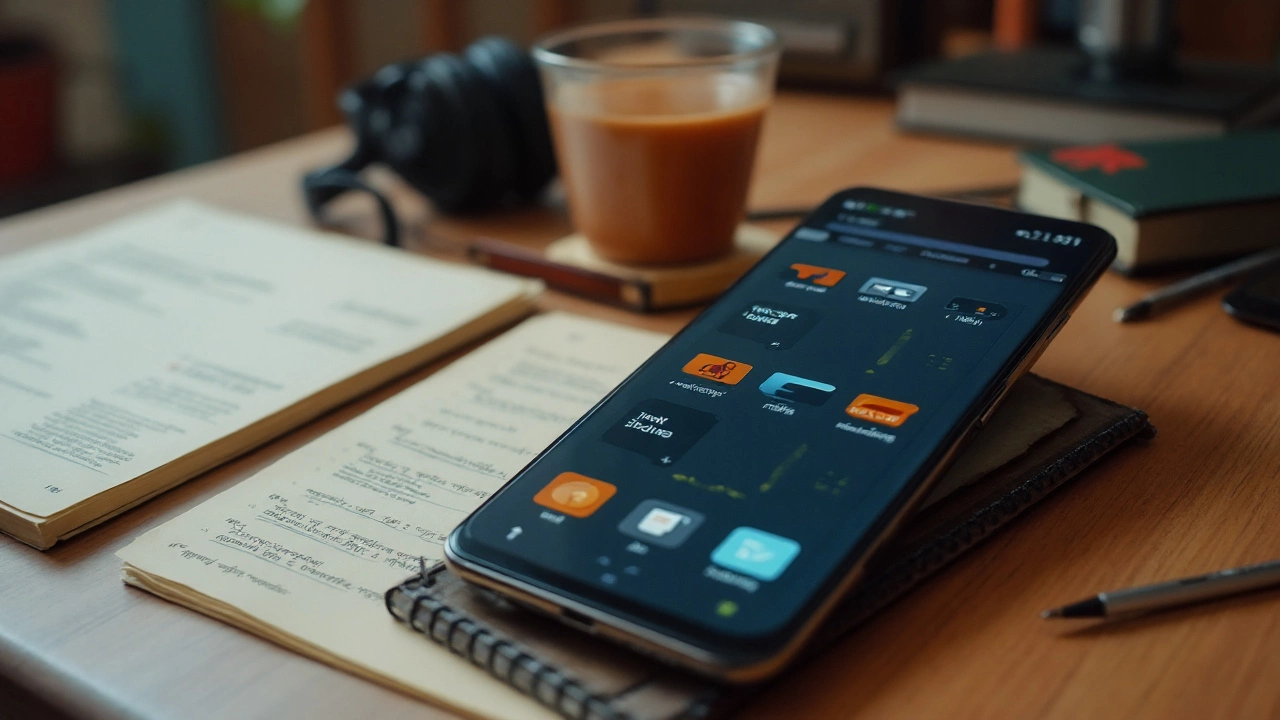Ever been stuck on a train or waiting in the endless bank line and caught yourself thinking: isn’t it wild I’m scrolling news, texting, and even running my to-do list from my phone, but coding just seems off-limits? My son Rohan whipped out his phone during a school break to fix a Python bug last week, and I suddenly realized I barely do that myself. But is it practical—or just an overpriced touchscreen flex?
Turns out, serious programmers are coding entire apps, building websites, and even running full software projects from their phones. The catch? You need the right gear, a little patience, and a muscle memory that laughs in the face of autocorrect. If you still think coding only happens on chunky laptops, you’re missing the latest twist in tech. Phones in 2025 are powerhouses, and the whole "you can’t code on mobile" myth… it’s outdated.
What Coding Looks Like on a Smartphone
All right, let’s get honest—nobody’s churning out massive data-driven apps on a 6-inch screen just for fun, but the landscape for mobile coding is way better than people think. Most modern Android and iPhone devices run processors and memory that wipe the floor with what old laptops could manage. According to a 2024 Statista report, nearly 35% of new developers say they’ve written at least part of a codebase on their phone. It’s not a fringe thing anymore; it’s real and growing.
So why bother? The answer is flexibility. Imagine sitting at your kid’s swimming class, having an hour to kill, and actually solving that problem you couldn’t shake off at work. Or updating a client’s website during a vacation without dragging your laptop to the beach. This freedom wasn’t even a dream a few years ago.
The big trick: pick the right app for the job. There’s a world of difference between writing code in a basic notes app and using something like Pydroid (for Python), AIDE (Android app development), or Juno (for Jupyter Notebooks on iOS). Apps like Dcoder and OnlineGDB support multiple languages, from JavaScript and C++ to PHP. You’ll find features like syntax highlighting, code autocomplete, and even built-in compilers—stuff desktop IDEs are known for. Dcoder, for example, supports over 50 coding languages and offers a slick split-view editor, so you can edit and run code almost like on a real computer.
And don’t forget keyboards. Typing code on an onscreen keyboard is… let’s just say I have sympathy for my thumbs. But it’s totally manageable if you hook up a Bluetooth keyboard (these start around ₹600 on Amazon or Flipkart). Suddenly, spaces, brackets, and those maddening semicolons aren’t a hassle. Even without external hardware, software keyboards like Hacker’s Keyboard let you access all those programmer symbols right on screen. I set this up for my daughter Kavya, and she got so good at it I had to look up her code twice to believe it wasn’t done on a laptop.
Ever heard about cloud IDEs? Platforms like Replit, GitHub Codespaces, and Glitch let you code right from Chrome or Safari, syncing projects instantly and running code in sandboxes that behave like Linux servers. Google even revealed that 19% of their open-source contributors have used a cloud IDE at least once this year, a huge jump from the 4% back in 2022.
Battery life used to be a worry. Not so much now. Today’s flagship phones have 4000mAh+ batteries; coding on lightweight apps barely sips juice compared to gaming or video streaming. And recent Snapdragon benchmarks show a phone like the Samsung Galaxy S25 can compile a medium-sized Python file in under a second—faster than some Chromebooks.
Screen space is tight, true. But tabs, code folding, and split views are now standard in most good mobile code editors. Plus, exporting code to Dropbox, Google Drive, or GitHub takes a couple of taps. Have a collaborative project? Tools like Live Share on Visual Studio Online or just sharing a GitHub link works fine—even on mobile. A 2025 developer survey said almost 14% of new app features on Play Store were first prototyped on a phone or tablet. That’s bonkers.
What you can actually do: write scripts (Python, PHP, JS), fix bugs, review pull requests, edit websites, test algorithms, and even deploy cloud functions. What’s still a pain? Heavy front-end work, huge projects, and anything needing big resource files or lots of multitasking. But for learning, tinkering, and quick fixes, the mobile scene is wide open.
| Popular Mobile Coding Apps | Language Support | Key Features |
|---|---|---|
| Dcoder | 50+ | Syntax highlighting, cloud sync, multi-language |
| Pydroid 3 | Python | Offline compiler, pip support, NumPy/SciPy |
| AIDE | Java, Kotlin | Build Android apps, real device emulator |
| Juno | Python, Jupyter | Notebook interface, graphs, iCloud sync |
| OnlineGDB | Multiple including C/C++ | Debugger, compiler, collaborative editing |
| GitHub Codespaces | Any (online) | Cloud IDE, extensions, Git integration |
You might face a learning curve, but your phone can legit become your pocket coding tool, whether you’re a pro, a curious teen, or a bored dad waiting for lunch to cook.

Real-World Use Cases: When Does Coding on Your Phone Make Sense?
Coding on a phone isn’t just a geek party trick or a desperate move. It comes into play in plenty of everyday scenarios and some surprising professional workflows. My friend, an Android developer, actually rushed out an emergency patch for his app from the back seat of an Uber stuck in Mumbai traffic. It saved his rating and his relationship with his boss. He used AIDE, connected to GitHub, pushed a commit, and the world kept spinning.
You can keep up with online coding classes or bootcamps even if you don’t own a laptop. According to the 2025 Coursera stats, almost 21% of users who finish Python basics do most of their lessons from mobile devices. This is especially handy in places where desktops are expensive or just not practical to haul around—perfect example: college hostels with “BYOD” (bring your own device) policies swarming all over India.
If you’re helping others learn code—for example, giving your kids a Python lesson at a café—nothing beats the flexibility of a phone. Download Juno Lite, write a quick script, let them run it, change a couple of lines, and boom—they grasp the logic instantly. Interactive learning, zero setup time, works even on borrowed Wi-Fi.
Debugging is another golden area. Imagine getting a panicked Slack or WhatsApp message: "the site’s down, code is behaving funny." Pull out your phone, check out the error, fix a line, and commit in five minutes, not in hours after hunting for a laptop. Everyday real-life productivity gains, not hypothetical productivity.
Of course, there are fun use cases too. You’re on a trip; you want to automate your Instagram photo uploads. Why not script it batch-style from bed? I’ve written silly games, server bots, and database queries during family holidays—all on my beat-up Android. Kids love being "hackers," and it’s honestly both learning and bonding time for us.
If you look at the professional scene, even harder-core tasks like reviewing pull requests, commenting on code, or writing infrastructure-as-code YAMLs are totally possible from phones using GitHub and VS Code Online. I know a Mumbai fintech team (mid-level devs, not interns) that collaboratively edited their Terraform files on mobile during a business trip delay at Delhi airport. Nobody batted an eye.
Cloud engineering and serverless functions? Platforms like AWS Lambda, Google Cloud Functions, or even Heroku’s dashboard let you deploy, monitor, and tinker with serverless code on mobile browsers. The only time I physically had to visit my laptop last year was when I blew up a database (don’t ask).
Still, let’s talk about some of the boundaries. Don’t expect to build gigabyte-sized Unity games or run Docker containers natively—phones just aren’t set up for those jobs yet. Anything requiring huge RAM or intricate graphical UIs is much better on desktop. But all the lighter stuff, from scripting to web fixes to on-the-fly code reviews, is in reach, literally, whenever you’ve got your phone—sometimes even when you don’t have a stable power supply.
But before you run into the wild west of mobile coding, set up some best practices. Use cloud storage religiously—phones get lost, stolen, or run out of space pretty fast. Enable auto-save and sync with Google Drive or iCloud. Double-check your syntax because your pinkie will miss key combos. And don’t ignore basic ergonomics: coding in bed with your neck craned is a chiropractor’s payday. Short bursts work better—think 20–30 minutes at a time.
If security matters (especially for work), enable device encryption. Two-factor authentication for your code repos is easy to set up; platforms like Bitbucket and GitHub promote it natively. One cool tip: some editors let you fingerprint-lock access, so your code stash is private even if your phone lands in the wrong hands.
Wrap up with the craziest bit: as of June 2025, the Google Play Store lists over 140 coding IDEs or code-related apps specifically for mobile, a jump of almost 50% in just two years. Coding on a phone isn’t a fallback or a gimmick; it’s a mainstream tool—and it’s crazy useful when you know where to point your thumbs.

Tips, Tools, and Tactics for Getting the Most out of Phone Coding
If you’re ready to try coding on your phone, there’s just a little setup to keep it smooth. First, think about what you want to build. Serious Android app dev? Go for AIDE, which compiles Java/Kotlin projects right on your device and even lets you run apps in an emulator. Quick Python scripts? Pydroid 3 shines since it works entirely offline, supports pip installs, and comes bundled with NumPy and matplotlib—makes practicing DSA (Data Structures & Algorithms) a breeze during break time.
For web stuff, Dcoder and Quoda are two strong picks. They come with code on phone features like autosave, syntax help, and can tie into cloud storage. You can set up FTP to deploy sites when you’re away from your usual gear. Juno is golden for those who love Jupyter Notebooks—drag-and-drop graphs, interactive charts, all on iOS.
The keyboard is truly the unsung hero or villain. Stock keyboards feel slow (especially on iOS). Download something like Hacker’s Keyboard or an external Bluetooth keyboard to speed up brackets, curly braces, and arrow keys. Typing a function call on a tiny phone sure isn’t glamorous, but with shortcuts set up, it gets quick.
Keep your environment lean. Don’t hoard hundreds of heavy files or logs; archive them to Google Drive or Dropbox as you go. Use GIT GUI apps (like MGit on Android or Working Copy for iOS) to keep your commits in order and review changes. These tools offer a simple touch interface to stash and push code—no command line needed. And pair your editor with a version control service like GitHub or Bitbucket for backup and collaboration. It only takes a couple of taps to switch branches or open pull requests, and GitHub’s code viewer works surprisingly well on small screens for code reviews.
Be smart about multitasking. Split-screen modes (standard on most Androids and iOS tablets) let you browse Stack Overflow while you code or watch a quick tutorial side-by-side. Don’t be shy about asking for help—dev forums and Discord servers work totally fine on mobile, and you’ll find pros answering code questions even after hours, sometimes in their own living rooms. The tech support vibe is real-time.
Automate what you can. Tools like Termux (Android) let you run a Linux shell—run bash scripts, manage SSH sessions, and ping servers, all on your phone. Whenever I need to monitor a server or debug API calls for clients, I use JuiceSSH (Android) or Blink Shell (iOS). If your phone supports stylus input, apps like Carnets (Jupyter clone for iOS) make code sketching super easy, almost like a tablet. Kavya actually drew out an entire data flow for her school assignment, annotated it, and shared it as a screenshot from her iPhone.
Don’t underestimate tutorials and structured learning apps. SoloLearn, Grasshopper, and Mimo deliver bite-sized interactive lessons—great for days when you can’t bear typing long code but want to keep your skills sharp. They won’t fully replace hard-core practice, but these apps trick your brain into thinking you’re just browsing reels, not smashing through JSON objects. A 2025 App Annie stat showed coding education apps saw a 120% annual usage jump—people want micro-learning and they want it now.
Now, is it efficient to code entire projects on your phone? Probably not for most long-term, full-scale work, but it’s perfect for practice, quick fixes, and learning—especially while you’re away from home turf. The point isn’t to ditch your laptop entirely but to have a stealth coder’s toolkit right in your pocket. If your colleagues, friends, or even your kids have ever tackled or debugged code on a phone, you’re witnessing a totally normal part of modern tech.
If you decide to make mobile coding a regular gig, set up routines to prevent mistakes. Sync your code every day, use password managers to keep credentials safe, and always double-check your changes before pushing to production—they may look fine on a 6-inch phone, but the real test is desktop or production runs.
So the next time you’re stuck in traffic, waiting at the airport, or just bored during a dull relative’s speech, remember: your phone can code. Pick the right apps, set up your gear, keep your data safe, and you’re set. It’s a cool way to stay productive, build skills, and maybe even impress your kids. Who knew your phone could hack it?
